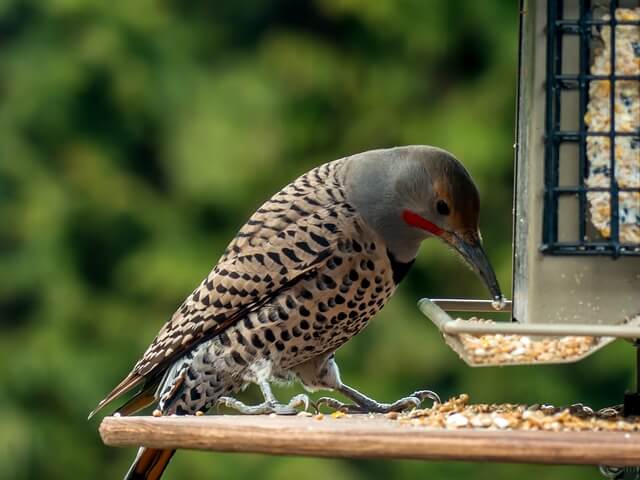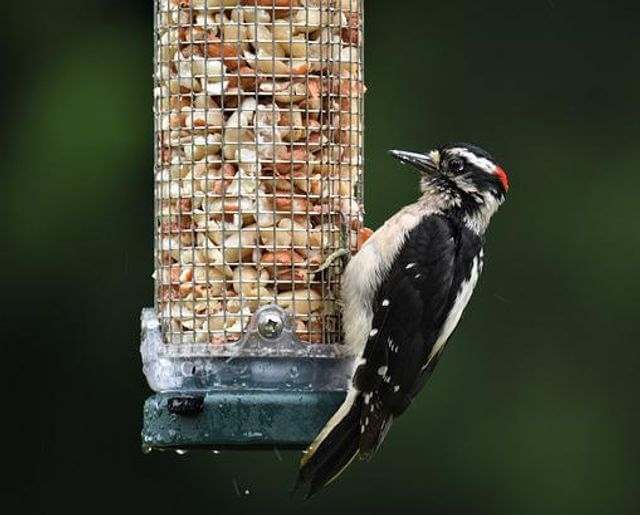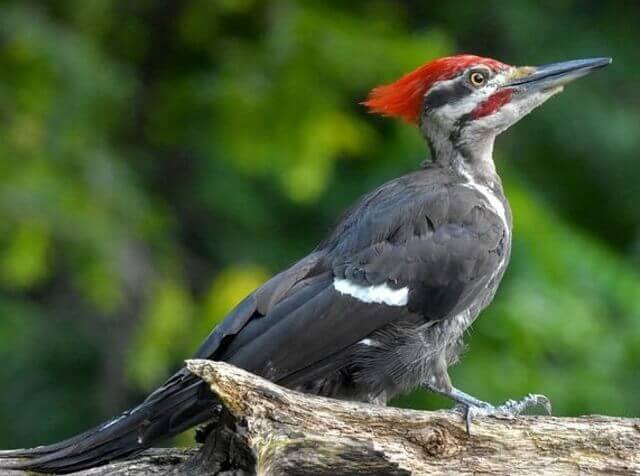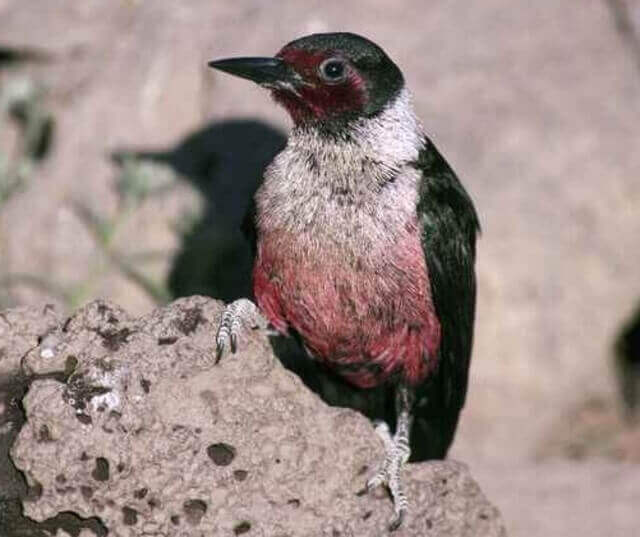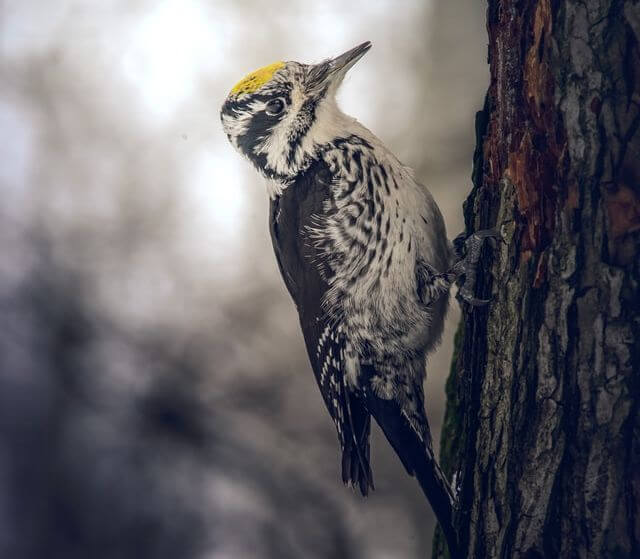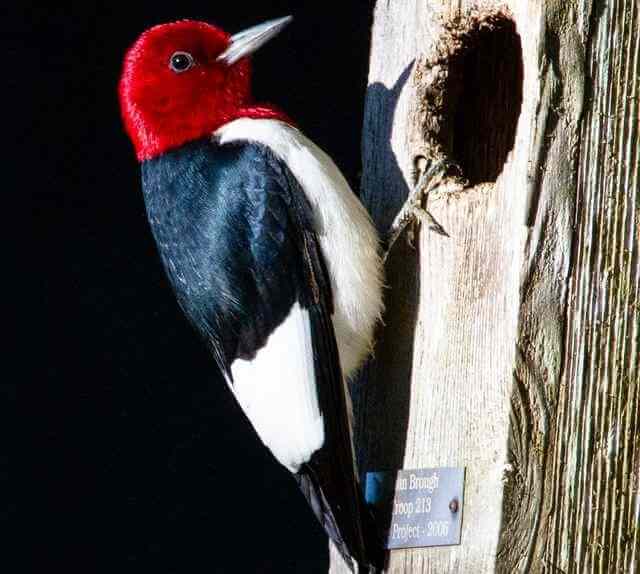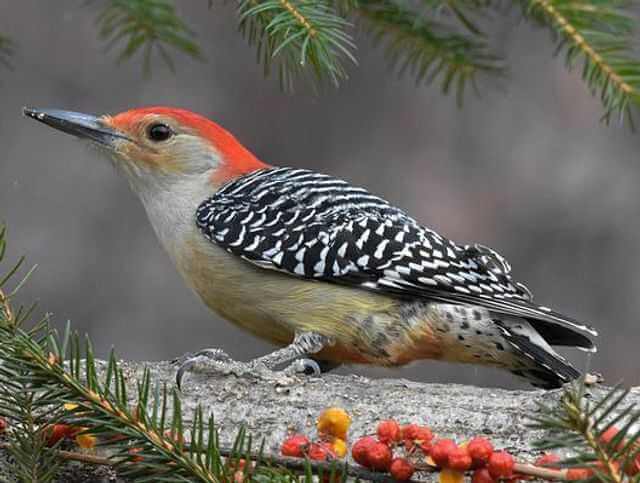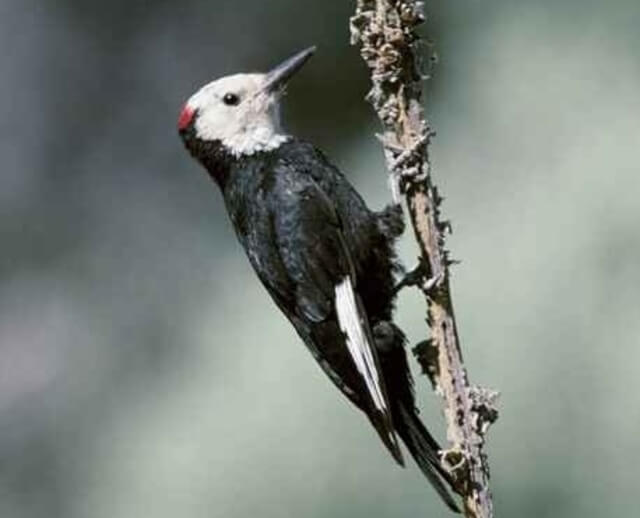Tennessee boasts a rich avian diversity, including an array of captivating woodpecker species. In this ultimate guide, we delve into the top 10 types of woodpeckers found in Tennessee.
From the striking Pileated Woodpecker to the diminutive Downy Woodpecker, learn about their habitats, behaviors, and identifying features.
Whether you’re a birding enthusiast or a curious nature lover, this guide provides valuable insights into Tennessee’s woodpecker population.
Table of Contents
Woodpeckers in Tennessee
Northern Flicker
- Length: 11.0-12.0 in (28-31 cm)
- Weight: 3.9-5.6 oz. (110-160 g)
- Wingspan: 16.5-20.0 in (42-51 cm)
- Scientific Name: Colaptes auratus
- Frequency of Occurrence: 31.64% (Statistic by: eBird)
- Where To Find Them: They can be found in locations such as the Great Smoky Mountains National Park and the Cumberland Plateau. They are also found in areas near streams and rivers. Northern Flickers eat insects, which they find by pecking into tree bark.
- How To Attract: They are easily attracted to feeders with suet or peanut butter, and they also like to eat insects. You can attract Northern Flickers to your yard by putting up a birdfeeder and placing a few logs or branches in your yard for them to perch on.
Description: Northern Flickers are common woodpeckers found in North America. They have a range that extends from Alaska to Central America. In the United States, they are most commonly found in the eastern and central parts of the country.
Northern Flickers prefer forested areas, but can also be found in open habitats such as pastures and prairies. They eat mostly insects, but will also eat fruit and seeds. Northern Flickers build their nests in tree cavities or on top of fence posts or buildings.
Related Post: How to Attract Northern Flickers to your Backyard (Easy)
Downy Woodpecker
- Length: 5.5-6.7 in (14-17 cm)
- Weight: 0.7-1.0 oz. (21-28 g)
- Wingspan: 9.8-11.8 in (25-30 cm)
- Scientific Name: Picoides pubescens
- Frequency of Occurrence: 12.12%
- Where To Find Them: Downy Woodpeckers are also common in urban areas. These birds can be seen in a variety of locations throughout the state, including the Great Smoky Mountains National Park, Rocky Top Wildlife Refuge, and Cherokee National Forest.
- How to Attract: The downy woodpeckercan be easily attracted to backyard birdfeeders by offering a variety of foods. They especially love black oil sunflower seeds, but will also eat niger thistle, millet, and cracked corn. They are also attracted to suet feeders, where they can peck at the soft suet or use their strong bills to pry off small pieces. In order to keep Downy Woodpeckers coming back to your yard, you should continue to provide a variety of food sources throughout the year.
Description: Downy woodpeckers are typically found in North America and Canada, but can also be found in Central America, South America, and Eurasia. Downy woodpeckers live in a variety of habitats, including forests, woodlands, parks, gardens, and even urban areas.
Downy woodpeckers eat a variety of insects and other invertebrates. They also consume fruit and sap from trees. Downy woodpeckers build their nests in tree cavities or behind loose bark.
Related Post:
- How to Attract Downy Woodpeckers to Your Yard? (Easy!)
- 7 Birds That Look Like Downy Woodpecker (Explained)
Hairy Woodpecker
- Length: 7.1-10.2 in (18-26 cm)
- Weight: 1.4-3.4 oz. (40-95 g)
- Wingspan: 13.0-16.1 in (33-41 cm)
- Scientific Name: Picoides villosus
- Frequency of Occurrence: 6.98%
- Where To Find Them: The Hairy Woodpecker is found in Tennessee in many different areas. They can be found in the eastern parts of the state, near the Cumberland Plateau and in the Appalachian Mountains. They can also be found in other rural and forested areas throughout the state.
- How to Attract: These woodpeckers are attracted to dead or dying trees, where they feed on insects. If you want to attract these birds to your backyard, you can provide them with a dead tree or post, as well as a source of water. You can also put up a birdfeeder with suet or peanut butter to attract them.
Description: The Hairy Woodpecker is a common sight throughout most of the eastern half of the United States. These birds prefer to live in deciduous forests, but can also be found in mixed woodlands and suburban areas. The Hairy Woodpecker is a versatile bird, eating insects, nuts, and seeds.
They are known for their characteristic drumming on tree trunks, which they use to communicate with other woodpeckers. Hairy Woodpeckers build their nests in trees, often using abandoned nests of other birds or squirrels.
Pileated Woodpecker
- Length: 15.8-19.3 in (40-49 cm)
- Weight: 8.8-12.3 oz. (250-350 g)
- Wingspan: 26.0-29.5 in (66-75 cm)
- Scientific Name: Dryocopus pileatus
- Frequency of Occurrence: 3.30%
- Where To Find Them: The Pileated Woodpecker is one of the largest woodpeckers in North America. They are usually found in mature forests and can be found in a variety of locations in Tennessee, such as the Cumberland Plateau and the Appalachian Mountains. They prefer to live in areas with large trees where they can find food, but they have also been known to inhabit open areas near water.
- How To Attract: These birds can be attracted to your backyard by providing them with the right food and habitat. Pileated Woodpeckers prefer to eat insects, but will also eat fruit, nuts, and seeds. You can provide them with food by setting out a feeder filled with suet, peanuts, or sunflower seeds. Be sure to keep the feeder clean and refill it regularly. You can also attract Pileated Woodpeckers to your backyard by creating a bird-friendly habitat. This includes providing a variety of trees and branches for them to perch on, as well as dead trees or logs for them to excavate.
Description: The Pileated Woodpecker is a North American bird that ranges from southern Canada to northern Mexico. They inhabit deciduous and mixed forests, as well as woodlands near rivers and streams. These woodpeckers primarily eat insects, but will also consume fruit, nuts, and seeds.
They nest in tree cavities, digging their own nests if necessary. The female lays 3-6 eggs, which the male incubates for about 2 weeks. The young birds are fed by both parents and stay with them for about 8 weeks.
Related Post: How to Attract Pileated Woodpeckers to your Yard (Fast)
Lewis’s Woodpecker
- Length: 10.2-11.0 in (26-28 cm)
- Weight: 3.1-4.9 oz. (88-138 g)
- Wingspan: 19.3-20.5 in (49-52 cm)
- Scientific Name: Melanerpes lewis
- Frequency of Occurrence: 1.26%
- Where To Find Them: Some spots that are great locations for spotting these woodpeckers include the Cherokee National Forest, the Great Smoky Mountains National Park, and the Radnor Lake State Natural Area. These woodpeckers can also be seen in other parts of Tennessee such as Memphis, Knoxville, and Chattanooga. They typically stay in wooded areas near water sources, so birders who are looking to see them should scan around riverbanks and other forested areas.
- How to Attract: There are several things you can do to attract Lewis’s woodpeckers to your yard.
One way to attract these birds is to provide them with a food source. Lewis’s woodpeckers eat insects, so providing a feeder filled with suet or black oil sunflower seeds will help bring them in. You can also place a log or stump in your yard for the birds to search for insects. Another way to attract Lewis’s woodpeckers is to create a nesting site.
Description: Lewis’s Woodpecker (Melanerpes lewis) is a medium-sized woodpecker that ranges from the western United States to Mexico. They inhabit open woodlands and forests, as well as orchards, riparian corridors, and other semi-open habitats.
Lewis’s Woodpeckers forage on the ground for insects and spiders, as well as for nuts, fruits, and sap. They nest in tree cavities, excavating their own nests or using natural cavities or abandoned nests of other birds.
American Three-toed Woodpecker
- Length: 8.3-9.1 in (21-23 cm)
- Weight: 1.6-2.4 oz. (44.8-67.9 g)
- Wingspan: 14.6-15.3 in (37-39 cm)
- Scientific Name: Picoides dorsalis
- Frequency of Occurrence: 0.5206%
- Where To Find Them: The American three-toed woodpecker is found in many locations in Tennessee. They can be found in the Great Smoky Mountains National Park, and also in the Cumberland Plateau. In these areas, they live in a variety of habitats including hardwood forests, pine forests, and oak savannas. They are also found in open areas with scattered trees, such as pastures and agricultural land.
- How to Attract: If you want to try and attract American Three-toed Woodpeckers to your yard, here are some tips to help you out. Ensure that the birds have a water source. This could be in the form of a bird bath or a small pond. Offer a variety of food options for the birds, including nuts, seeds, fruits, and insects. Create a habitat that resembles their natural environment by planting trees and shrubs and leaving dead logs lying around. Keep your yard clean and free of harmful chemicals.
Description: The American Three-toed Woodpecker is a medium-sized woodpecker that is found in North America. This species can be identified by its black and white plumage, as well as its distinctive three toes on each foot. The American Three-toed Woodpecker inhabits coniferous and mixed forests, and prefers to live in areas with large trees.
These birds primarily eat insects, but also consume fruit and nuts. American Three-toed Woodpeckers nest in holes in trees, typically excavating their own homes or using abandoned nests of other birds.
Black-backed Woodpecker
- Length: 9.1 in (23 cm)
- Weight: 2.1-3.1 oz. (61-88 g)
- Wingspan: 15.8-16.5 in (40-42 cm)
- Scientific Name: Picoides arcticus
- Frequency of Occurrence: 0.1673%
- Where To Find Them: In Tennessee, they are found in the eastern part of the state in the Cumberland Plateau and Ridge-and-Valley Appalachians. They prefer open areas with large trees for foraging and nesting.
- How to Attract: If youwant to attract them to your backyard, there are a few things you can do. Black-backed woodpeckers prefer tall conifers for nesting and foraging. They also like dead trees and large limbs for foraging. To attract them to your backyard, provide a tall coniferous tree and plenty of dead trees or large limbs. You can also put up a feeder filled with suet or black oil sunflower seeds.
Description: The Black-backed woodpecker (Picoides arcticus) is a medium-sized woodpecker found in North America. It ranges from the Yukon in the north to New Mexico and central Texas in the south, and from the Atlantic coast to the Pacific coast.
The black-backed woodpecker is mostly found in coniferous forests, but also inhabits deciduous forests and riparian corridors. It feeds on insects, larvae, and occasionally fruits. This woodpecker nests in tree cavities, often excavating its own nest hole.
Red-headed Woodpecker
- Length: 7.5-9.1 in (19-23 cm)
- Weight: 2.0-3.2 oz. (56-91 g)
- Wingspan: 16.5 in (42 cm)
- Scientific Name: Melanerpes erythrocephalus
- Frequency of Occurrence: 0.1560%
- Where To Find Them: Red-headed Woodpecker can be found in Tennessee in many different locations. Some spots include the Cumberland Plateau, the Highland Rim, and the Tennessee River Valley. They are also commonly found in areas near water, such as streams, rivers, and lakes.
- How to Attract: They are attracted to open areas with large trees, where they can find food and shelter. There are a few things you can do to make your property more attractive to these birds, and increase the chances of seeing them. One way to attract red-headed woodpeckers is to provide them with a source of water. A small pond or birdbath will do, as long as it is shallow and has some rocks or other features for the birds to perch on. You can also plant trees and shrubs that provide food for the birds, such as sumac, hackberry, and dogwood.
Description: The Red-headed woodpecker is a medium-sized woodpecker found in the eastern and central United States. The bird ranges from southern Canada to northern Florida, and west to Texas and Oklahoma. It inhabits open woodland areas, as well as parks and suburbs.
The diet of the red-headed woodpecker consists mostly of insects, but it will also eat fruit, seeds, and nuts. The bird nests in tree cavities, using mud to form a protective coating around the opening.
Related Post:
- Interesting Red-Headed Woodpecker Facts (Explained)
- Birds That Look Like A Red-headed Woodpecker(Explained)
Red-bellied Woodpecker
- Length: 9.5 in (24 cm)
- Weight: 2.0-3.2 oz. (56-90 g)
- Wingspan: 13.0-16.5 in (33-42 cm)
- Scientific Name: Melanerpes carolinus
- Frequency of Occurrence: 0.0027%
- Where To Find Them: This bird can be found in a number of locations around the state including the Cumberland Plateau, the Highland Rim, and the eastern part of the state.
- How to Attract: Red-bellied woodpeckers are common in North America and can be found in a variety of habitats. They often visit backyards, where they can be attracted to feeders that offer suet or sunflower seeds. Properly placing a bird feeder in your yard and keeping it clean will help attract these birds. You can also provide trees or large shrubs that offer natural nesting sites and food sources.
Description: The Red-bellied woodpecker is a common bird found in eastern North America. It ranges from southern Canada to Florida and west to Texas. This woodpecker inhabits a variety of habitats, including forests, woodlots, parks, and suburban areas.
They are usually found near water. The diet of the red-bellied woodpecker consists of insects, nuts, berries, and seeds. They nest in tree cavities, sometimes using abandoned holes made by other species of woodpeckers.
Related Post: How to Attract Red-bellied Woodpeckers to your Yard?
White-headed Woodpecker
- Length: 7.9-9.1 in (20-23 cm)
- Weight: 1.9-2.3 oz (55-65 g)
- Wingspan:16.9 in (43 cm)
- Scientific Name: Picoides albolarvatus
- Frequency of Occurrence: 0.0001%
- Where To Find Them: The white-headed woodpecker is a Tennessee bird that can be found in locations including the Cumberland Plateau and the Appalachian Mountains. These woodpeckers like to live in areas with large trees, where they can find plenty of food. They eat insects, nuts, and berries.
- How to Attract: First, make sure you have a good variety of trees and shrubs in your yard. The white-headed woodpecker likes to feed on insects that are found in the bark of trees. You can also provide a birdfeeder with suet or insect-rich seed to attract this bird.
Description: The White-headed woodpecker is a medium-sized bird that is found in eastern and central North America. This species inhabits deciduous forests and woodlands, where it feeds on insects that are found on tree trunks and branches. White-headed woodpeckers nest in a hole that they excavate in dead trees or rotting logs.
These birds typically lay four to six eggs, which are incubated by the female for about two weeks. The young chicks remain in the nest for another two weeks before fledging.


